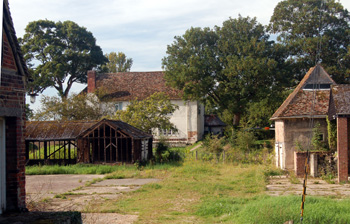
Manor Farm and barns August 2009
Domesday Book was commissioned by William the Conqueror (1066-1087) at Christmas 1085. It was designed to show who held every piece of land in the newly conquered Kingdom of England. It was known colloquially as the Domesday Book because it was seen as being as final as the Last Judgement and as difficult to conceal things from. The book does not cover the whole country - Cumberland, Durham, Northumberland, and Westmorland were omitted and London and Winchester likewise, along with some other towns. A separate book, called Little Domesday covered the counties of Essex, Norfolk and Suffolk and, despite its name, it is actually bigger and more detailed than the Great Domesday Book containing the other counties.
Hugh de Beauchamp owned Colmworth at Domesday and it formed part of his Barony of Bedford. His tenant was clearly a native, his name being Wimund. The holding consisted of 5 hides and included 12 villagers, 13 smallholders and a slave. This total of 26 needs to be multiplied by at least a factor of four to account for these men's dependents, giving a possible total population of just over a hundred. The holding contained enough woodland for 200 pigs.
Aki, a thegn of King Edward the Confessor, had held the place in 1066 and eight Freemen also had their own land which they could grant or sell freely. The value at that time had been £4 which, somewhat unusually, had risen to £5 by 1086, indicating that if Colmworth had suffered from the depredations of William I's army, like so many places in Bedfordshire, it had made a rapid recovery.
The Domesday Book also identifies two other holdings at a place called Chainhalle - which some have identified with Channels End. One holding, of five hides, was held by Hugh de Beauchamp himself, without a tenant. It included twelve villagers, nine smallholders and five slaves - a total of twenty six, suggesting, as with Colmworth itself, a population of somewhere over a hundred. The holding included a mill valued at fifty shillings and a hundred eels and woodland for a hundred pigs. The only natural watercourse in this area is Begwary Brook but it is possible that Chainhalle is nothing to do with Colmworth but closer to Bedford [see below]. Before 1066 this holding had been worth £7, reduced to £5 when Hugh acquired it but the value had risen to £8 by 1086.
The other holding in Chainhalle was, again, in Hugh's own hands. The extent was just half a hide "which lies in Putnoe lands". This last reference would put the land just north of the town of Bedford, as it was then, not Colmworth and, certainly the next entry in the Book refers to Goldington. Clearly this throws the identification with Channels End into doubt, unless this second reference is not to Chainhalle but to Goldington and has been, by mistake, put before the main entry rather than after it [The entry begins "in the same place" and would refer to Chainhalle as it followed that entry]. The other explanation might be that there were two places called Putnoe, one of them in Colmworth and we will probably never be sure which explanation is correct! This Putnoe land included two smallholders and was valued at £2, its pre-Conquest figure, when it had been owned by Askell, a thegn of King Edward the Confessor.